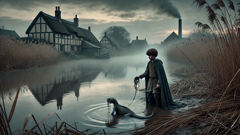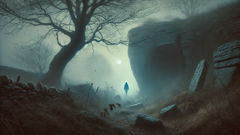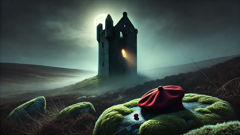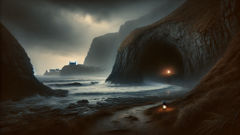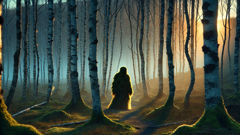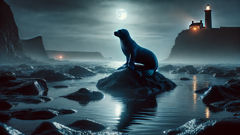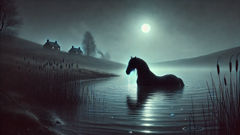Introduction
On the western slopes of the Highlands where rain returns like a promise and the mountains keep their secrets, the lochs sit in black mirrors. The people who live near those waters learned long ago to read their moods: the way wind combs the reeds, how mist folds like wool, which banks the otters refused to cross after dusk. Among the most guarded teachings was the tale of the Each-uisge, the water horse who was not a horse at all but a hunger that wore a horse's skin. Folk spoke of it with a hush, as if naming the creature too loud might summon it from depth. It was said the Each-uisge came from the brackish edges where sea met fresh water, an old mixing of tides and old wrath, a being more cunning than the kelpie and more merciless than any wolf. When the moon lay flat and white on the loch, the Each-uisge would climb ashore, slick mane dripping like spilled ink, and present itself as a magnificent mount with eyes that held a reflected sky. At first glance the beast promised safety and pride to any rider; by the time its black, webbed lips closed round the throat, the promise turned to salt and teeth. This story gathers that lore: the sightings, the warnings carved into stone and memory, the families who lost more than livestock, and the small cunning used by those who learned how to flee or bargain. It is part natural history and part moral compass, a caution stitched to the landscape of the Highlands to explain why some lochs are left alone after sundown and why certain shores wear a ring of riverside offerings.
Origins, Descriptions, and Sightings
Folklore seldom arrives fully formed; it grows out of conversations, accidents, strange tides, and the need to explain what refuses easy explanation. The legend of the Each-uisge was born in those cold conversations, at hearths where old women stitched and fishermen cleaned nets, at drovers' inns where men traded news and superstition over peat-smoke ale. The stories vary by glen and by the mood of the teller, yet certain threads remain consistent: the animal appears from water, takes the shape of a horse or handsome rider, and lures the unwary to a drowning end. In some accounts the creature is born of the sea's bitterness—an old curse left behind by an offended god. In others it is simply the loch's appetite given form, an animistic expression of the wild need that governs predators and tides. To the oral historians of the Highlands, the Each-uisge is a vivid personification of a place that never belongs to people entirely.

Those who claimed to have seen the Each-uisge described it with a specificity that belied simple myth. It stood larger than the common horse, with a coat the color of quick water catching moonlight and a mane like kelp. Its skin was often described as being cold to the touch even when the evening air held only the mild dampness of spring. Its eyes were the most unnerving detail: pupils that dilated to full black, then flashed like distant beacons as if the creature carried its own private weather. Some witnesses said the hooves were webbed and left odd impressions in peat and sod, while others swore the beasts had obvious fishlike parts—scales along the flanks, a tail that kicked like a seal when it fled back to the water. Once it had a rider, the myth went, the Each-uisge always tried to shake them loose, plunge them under, and drag them home. Livestock losses were often blamed on the creature: a prized mare found turned to a small, cold carcass on a bank, a calf missing with hoofprints leading to the loch. Such tragedies are the raw data that render legend onto maps.
A pattern of recurring geographic details ties the sightings together and suggests why the Each-uisge evolved in Scottish imagination specifically. The creature favours lochs where fresh water meets the sea or where estuaries create brackish conditions—places that are neither wholly salt nor wholly sweet. These liminal waters carried in them both sea and river histories: tidal ghosts, drowned forests, and the bones of old trees. Where currents meet, strange things can collect—seaweed, shipwreck flotsam, and at times the bodies of drowned animals. To a community dependent on grazing, fishing, and careful reading of weather, an unexplained disappearance could be given shape by a tale that told other people how to watch the water. The Each-uisge stories were functional as well as fearful: they reinforced caution, explained losses, and helped elders teach children to respect thresholds.
Historic records, when they can be coaxed from parish notes and the occasional magistrate ledger, show an uneasy interplay between official skepticism and local conviction. A 17th-century kirk session record mentions a loch where cattle ceased to drink after an 'unaccountable terror' afflicted the herd. A magistrate in the 1700s wrote about fishermen who refused to take boats out after sundown and who paid a small protection fee to a travelling exorcist who was no more than a ritualistic charlatan and yet as effective as any cure when he stirred the people's imagination with salt and prayers. These entries are valuable not because they prove the creature's existence but because they record the social weight of the fear. Where the Each-uisge story is strongest, so too were communal practices designed to deter or placate the unknown.
The lore also outlines patterns of behavior that make the creature feel logically coherent in myth. It is drawn to children and solitary travelers; it is especially attracted to those who come to the water with desire, whether it is the desire to ride the magnificent beast, to fetch a child, or to take a drink on a hot day. A recurrent motif appears: the creature offers beauty or convenience—an impossible mount, an alluring companion—but requires trust in return, a trust it will never honor. That bargain mirrors many tales of trickster beings in global folklore, where the exchange is not coins or crops but attention and company. In practice, the Each-uisge stories warn against the seduction of effortless solutions. Ease often masks danger.
Certain witnesses insisted the creature could take human form completely, stepping from the loch as a handsome stranger who smelled faintly of fish and seaweed, whose clothes glistened with dew. These human-shaped forms were dangerous because they both blended and betrayed. They were often described in tales of lovers who never returned, in accounts of drifters who charmed a widow into following them into a skiff that tilted and sank when it reached deeper water. The narrative utility of the shapeshifter is clear: it domesticates fear and places it in the everyday fabric of seduction and trust. It made the idea of the loch walking into town a plausible cautionary tale for widows and young women.
Archaeological and environmental readings add context without dispelling the myth. Isolated lochs occasionally have peat bogs that swallow animals and preserve them, leading to partial remains found centuries later. Natural methane pockets can create odd bubbling and sounds across a loch surface, and sudden surges of tide can claim an unwary animal grazing too close to an estuary. Storms, too, will alter shorelines overnight. Humans, in such conditions, seek agency. They craft myths to make the world intelligible. The Each-uisge thus belongs both to nature and to narrative: it is what the people of the Highlands call a particular set of dangers, preserved in the sharp detail of story.
The cultural imprint of the legend stretches beyond direct accounts. The Each-uisge appears as a figure in songs, where a line will warn mothers to keep toddlers close at evening, and as motifs carved on boats and gateposts in some coastal settlements. Some families kept old charms—knotted cords, bones of river birds—tucked into crib slats because the inherited habit of precaution is a quiet kind of faith. It is worth noting that legends like the Each-uisge change as much as they preserve. Over centuries the creature has alternated between being a moral lesson about pride and a simple, elemental terror to be warded off. Its persistence is a testament to the way landscapes keep their myths.
Encounters, Customs, and the Measures of Survival
Beyond the anatomy of legend lies the social story of how communities responded. Stories of direct encounter with the Each-uisge teach as much about people as about the creature. In one well-circulated tale, a drover named Hamish guides his herd to a stream where a dark shape grazes on the bank as if it were a common mare. The beast is flawless, its coat shining like new leather. Young men, eager to claim a fine mount, circle it and joke at its wildness, until a girl called Mairi, watching from the path, warns them to keep away. She remembers an old rhyme her grandmother recited and refuses to let the bravest of the boys climb onto the creature. He laughs, mounts, and the horse, thankful for company, dives into a pool. The boy does not return. Only a hat floats back, bobbing like a black lily. Such tales serve social functions: they codify rules about respecting elders, listening to women who remember, and the cost of youthful hubris.
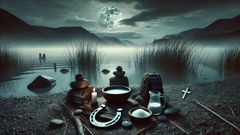
Customs evolved, many practical and some ritualistic, to reduce the number of such tragedies. Farmers cut hedgerows and built low stone fences where lochs met pasture, so cattle could not wander down precipitous banks. Villages established twilight watch systems, rotating responsibility for ferrying people and tending to children during the most dangerous hours. When livestock deaths occurred, elders sometimes interpreted them as a sign that the loch needed to be fed a small compensation. People left salt on the rocks, or a bowl of milk by a bank, small tokens of a bargain between human and water. These gestures are comparably rational: salt preserves, and milk in old beliefs contained a property that soothed certain spirits. Whether the Each-uisge liked milk is less relevant than the manner by which giving something visible asserted human agency over the environment.
Equally important were stories of cunning and narrow escapes. In a commonly told trick, a rider who realizes too late that his mount is water-born might reach into his boot and pull out a sharp stone to wedge between the creature's teeth, forcing it to open its mouth and letting the rider free. Another recurring tactic involves the use of iron. Many Highland tales assign iron properties that repel supernatural beings; a farmer might leave a horseshoe nailed to his barn door, not because a horseshoe is particularly magical, but because its presence signals preparation and practical care. In some accounts, invoking the name of a saint or reciting a particular Psalm will cause the creature to lose interest, protective gestures that show the syncretism of Christian and older animistic beliefs.
A less celebrated thread of the Each-uisge legend is the human cost of suspicion. In small communities, accusations of consorting with water spirits could fracture families. A lonely widow who walked the shore after dusk might become a subject of whispering, as neighbors asked whether she had been seen with a stranger. In times of scarcity, myths can be misapplied as scapegoats, and the line between prudence and paranoia is thin. The safety rituals, while often sensible, sometimes embattled those who fell outside communal lines: the poor, the traveling, the foreign. Tales of the Each-uisge thus reflect the way fear can both protect a community and exclude those who do not conform.
The personae who navigated this terrain were varied. There were professional fishermen whose knowledge of tides and churn made them wary interpreters of odd occurrences. Some, called water-singers or charmers, performed minor rites to ease local anxieties and occasionally to claim payment for their services. Traveling story-tellers and balladeers spread versions of the Each-uisge tale from town to town—each adding a flourish, a lesson. Women often served as the quiet authorities on the lochside, the keepers of lullabies and prohibitions, instructing children not to call to the water or to tease a strange horse into following them home. Men who made their living on the open water developed different rhythms of habit, staying out long hours and observing the loch as another kind of weather. These differing practices made for a culture of layered expertise.
Beyond human practice, naturalists looking at the Highland ecology can see plausible vectors for the persistence of the legend. Otters, seals, and even large fish like pike and salmon can behave in ways that surprise observers—surfacing near groups, tugging at bootlaces, and causing a tangle of activity in shallows. In low light, a sleek animal's shape can resolve into something more imposing; at a distance, a seal's head can loom like an equine muzzle. The human brain fills in absence with dangerous detail when survival is at stake. Myth emerges as a cognitive tool, a narrative shorthand to help groups predict and react to risk.
Nevertheless, some stories exceed mere survival logic and reach into the imaginative. One haunting sequence preserved in a coastal parish account describes a night when the loch boiled as if a kettle had been set to an impossible flame. A procession of horses rose from the depths, manes streaming like submerged banners, and two villagers witnessed the sight so clearly that they never spoke of it in the same voice again. Later, they were said to keep a bowl of salt at their door and to never let children play by the water after dusk. That such a sight could be mutually witnessed and later corroborated by community practices is evidence of the way myth and observation intertwine. The Each-uisge becomes a catalog of shared attention—what a community watches for and how it chooses to protect itself.
Finally, some modern reckonings with the legend show the Each-uisge recast as symbolic rather than literal. Writers and artists have treated the water horse as a figure for grief, for the pull of the past, and for the seductive and ruinous promises that nature and human desire sometimes make. In modern conservation terms, the Each-uisge narrative can be read as a warning about the fragile edge where human use meets wild ecology and about the consequences of ignoring that border. The old protections, charms, and lullabies are not only quaint survivals; they are archives of a community's long negotiation with its environment. Legends change, but they often preserve in striking metaphors the practical knowledge required to live in difficult places.
Conclusion
The Each-uisge survives in the Highlands because it answers more than one need: it explains sudden loss, it educates caution in an unforgiving landscape, and it gives form to the intimate fear of water, which is at once life-giving and capable of erasure. For centuries the tale shaped behavior—children were kept from shores after dusk, drovers avoided risky banks, and families left small offerings to a loch in the habit of bargaining with place. As modern life reshapes the Highlands and the lochs grow quieter or more visited, the tale of the Each-uisge endures as a cultural echo. That echo carries practical wisdom about boundaries and softens the harder lessons of drowning with narratives that preserve memory and communal care. Whether one hears the legend as an old, literal warning against a shape-shifting predator or as a poetic metaphor for the forces that pull and drown us, the Each-uisge remains a persistent presence on the map of Scottish imagination. It teaches respect for the liminal, the need for humility before the depth, and the human impulse to stitch story into landscape so that all who come later will know how to watch.



